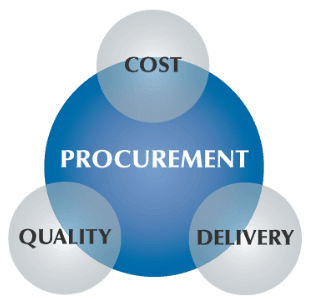Purchase Order
The
purchase order is placed with reference to the quotation. However, a purchase
order may be raised without any reference to a preceding document (Purchase
requisition or RFQ).
A
purchase order (PO) is a formal request or
instruction from a purchasing organization to a vendor or a plant to supply or
provide a certain quantity of goods or services at or by a certain point in
time.
It
forms part of the procurement process where requirement is converted to a
commitment to purchase. However, it is not necessary to start the process from
requirement processing as it can be created directly in the system dependent on
the operation need.
The
purchase order can be used for a variety of procurement purposes. In MyCompany, it is
used for the following purposes:-
Scenarios
|
Remarks
|
Procurement
of stock items – local
|
To
record all local purchases includes engineering spare parts, raw materials
and packaging materials.
|
Procurement
of imported material
|
This
includes all imports for raw material or semi finished and finished products.
A PO is raised based on each consignment to
track all follow-on processes.
|
Procurement
of non-stock and promotional items
|
Items
requested which are expensed off or charged out on receipt. Inventory
tracking on quantity basis of these items is required.
|
Procurement
of non-valuated items
|
Items
requested which are expensed off or charged out on receipt. Inventory
tracking of these items is not required.
|
Procurement
of CAPEX
|
Request
for assets.
|
Procurement
of services
|
For
services to be performed by contractor
|
Upon
approval of purchase request (from the PR process flow), the Purchase
Requisitions will be reviewed and processed by the purchasing. After completing
the sourcing process, the PR will be converted into the PO.
Multiple
purchase order types have been configured according to
MyCompany
’s requirement. All purchase order types will follow the same internal number range (4200000000 – 4299999999).
MyCompany
’s requirement. All purchase order types will follow the same internal number range (4200000000 – 4299999999).
Document type
|
Purchase Order Type
|
LPO
|
Local
Purchase Order
|
FPO
|
Foreign
Purchase Order
|
PPO
|
Promotional
Materials PO
|
MPO
|
CAPEX
Purchase Order
|
JSO
|
Job
Service Order
|
There
is some degree of variation in PO processing
steps as documented below:
·
The
standard PO process is used basically for stock and non-stock purchases where
it is differentiated by the ‘Account Assignment’ field in the PO
line.
·
Sales
Tax to be claimed will be treated via the Input tax code. Sales tax becomes a
part of the material and hence is to be entered via a sales tax condition.
·
Delivery
costs need to be incorporated for imports PO.
The steps are detailed in the Imports Section.
·
The
vendor prices can be maintained in the purchase info records, and will be
defaulted from there onto the purchase order.
·
Purchase
orders for services and subcontracting require different item categories to be
maintained against the PO line items. (For
details refer to the special procurement procedures section).
·
Shipment
date will be entered in a separate table manually from where it will be printed
on the purchase order script.
The
purchase order will be approved online using a two level release strategy
depending on the total value of the purchase order, if it is less than one
million the Purchase Manager and if it is exceeding one million the Head of
Supply Chain. The release strategy will be applied at the overall value of the
purchase order and will not be open to editing once it has been approved.
PO
can only be edited by the final release authority – (PO approval will be
revoked and initiator will change the PO)
The
promotional purchase order will be approved online using a four level release
strategy depending on the total value of the purchase order. It will be decided
in the realization phase who will have the authority to release the purchase
order and at which value it will be applied.
PO
can only be edited by the final release authority – (PO will be revoked and
initiator will change the PO)
The
follow-on activities for PO, such as the
receipt of goods and invoices are logged thus enabling the monitoring of the
procurement process.
The
goods are received against the purchase order. The vendor sends the materials
along with a delivery challan. The goods receipt is maintained in the system.
(Refer to the Inventory Section)
The
vendor sends a copy of the invoice with the sales tax invoice to the accounts
payable department and creates a liability against the vendor, depending upon
the type of purchase (Refer to the Invoicing Section)
·
Line
will be consolidated on PO Script and multiple lines will be shown in System.
·
Slab
based pricing conditions will be catered through Purchasing info records.

 1:20 AM
1:20 AM

1 comment
It's so nice article thank you for sharing a valuable content
Sap Online Access
Post a Comment